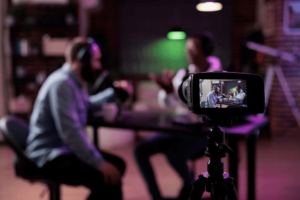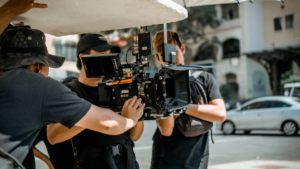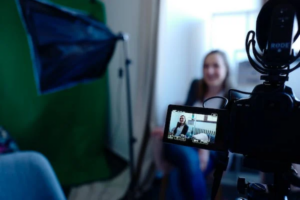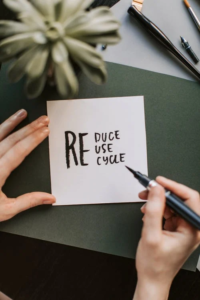The Meisner Technique is a unique training form that teaches actors to respond to stimuli and trust their instincts. It’s a great way to tap into your creative potential and embrace more authentic acting, to elicit realistic emotional responses from actors as a director, or to create compelling characters as a writer.
Renowned American actor and acting teacher Sanford Meisner developed his groundbreaking technique to guide actors in behaving instinctively and getting in touch with their emotions instead of getting trapped in their own thoughts.
Known as a “real people” technique throughout the world of acting, the Meisner Technique trains actors to look like and act like true human beings — instead of appearing as actors. Measured, integrated behavior makes Meisner-trained actors popular with filmmakers who are looking for varied yet particular behavior in a film. Realistic facial expressions and gestures hold up without seeming forced.
Many well-known actors throughout the years have practiced this technique, including Grace Kelly, Diane Keaton, Stephen Colbert, Alec Baldwin, Robert Duvall, and many more.
Main Components of the Meisner Technique
The three main tenets of the Meisner Technique include emotional preparation, repetition, and improvisation. These components all work together to help actors observe their scene partner and remain present instead of relying on memory or rehearsal. By focusing on preparation, repetition, and improvisation, actors can access creative reactions, building off of other actors around them and moving toward a reliance on organic, authentic instinct.
Emotional Preparation
Emotional preparation is the prep work Meisner believed any actor was obligated to carry out in order to develop the “imaginary circumstances” in a character’s life. According to Meisner, an actor must depict the full emotional landscape of a character to be interesting. You must learn and decide what makes a character happy, what causes conflict for them, and other complexities when doing this emotional preparation.
This acting technique allows actors to hone in on an understanding of the emotional life of their character, deepening a connection with a character’s personal experiences. The preparation moves actors away from an attempt to act as a character and instead react realistically and authentically. In other words, instead of acting sad or excited, an actor using the Meisner Technique really is sad or excited at that moment.
Some of the steps you will take through the Meisner Technique to perform research into a role include:
- Determining a character’s background and how it influences their decisions, feelings, reactions, and thoughts.
- Interviewing or speaking with other people who have the same or similar experiences that your characters do, especially if you have not had those experiences yourself.
- Tapping into the singular emotions of a character and letting those feelings transform into other related or totally different feelings, naturally going through a character’s emotions during an experience.
This research and preparation allow the actor to gain a personal, fuller perspective of the emotions a character has and the circumstances that create these emotions.
Repetition Exercise
The Repetition Exercise helps to train an actor’s responses. Instead of practicing a long dialogue, two actors practicing repetition using the Meisner Technique will face each other, repeating a phrase again and again while building on what the other says on each iteration. While the words stay more or less the same, the actors vary their intensity, tone, and emotion while speaking. The idea behind this exercise is to guide actors away from their comfort zone, promoting truth and spontaneity in the process.
In this exercise, actors focus on their underlying emotions instead of the actual words of dialogue. Instead of thinking of your acting as pretending to be someone you’re not, concentrate on being that someone and the authenticity and emotion while you speak. The Repetition Exercise can move to more advanced stages, adding physical tasks to the dialogue and in doing so, allowing for a more complex relationship between actors to develop. This main exercise in Meisner’s techniques trains actors to respond to different behaviors or circumstances, in different moments, all with complete truth.
Improvisation
Improvisation, which allows you to act before thinking, plays a key role in training with the Meisner Technique. Meisner’s form of improvisation involves actors truly doing what the character does based on instinct and emotional connection. Improvisation allows you to bring spontaneity into a scene and react in the mode of the character without relying on prescribed lines. Actors skilled in the Repetition Exercise can offer an impromptu reaction — often without words and in between lines — to any event.
Meisner vs. Method Acting
You’ve likely at least heard of both the Meisner and Method Acting techniques. Though the two are often confused, as they grew out of the same tradition, they are two distinct ideas today. Here are a few key components of each.
Method Acting:
- Focuses on internal information to develop a character.
- Draws on memory and emotional recollection.
The Meisner Technique:
- Relies on reaction and spontaneity.
- Encourages actors to improvise in response to external stimuli.
Is the Meisner Technique Right for You?
Once you’ve learned the basics of the Meisner Technique, you might wonder if this technique is right for you. Whether you’re looking to further develop your own acting or want to get the best out of your actors as a director or writer, this technique can give you the tools to better convey the stories you want to portray.
The Meisner Technique is a good fit for further study if:
- You find yourself overthinking your emotional responses as an actor. Actors who tend to get caught up in analysis of a character’s emotions instead of fluidly reacting when studying or prepping for scenes find the Meisner Technique helpful. The technique gives you the tools to react naturally before you get caught overthinking it.
- You want to learn how to elicit authentic responses on set as a director. Understanding how to guide actors so they spontaneously react, really demonstrating the truth in their character, will help make your films realistic.
- You’re interested in exploring human emotion and authenticity as a writer. Practicing acting, especially techniques like Meisner that challenge you to dig deeper into the authenticity of who a character is, can help you develop more life-like characters, craft more realistic dialogue, and write stories that capture the human experience in a more engaging and thoughtful way.
Who Was Sanford Meisner?
Sanford Meisner was respected as an actor even before making a name for himself with his eponymous technique. Meisner and a group of actors (including Stella Adler and Lee Strasberg!) formed a company in the early 1930s. This “Group Theatre,” as it became known, had studied Konstantin Stanislavsky’s naturalistic approach. They led the way in developing method acting, another famed approach.
The Group Theatre brought method acting to prominence in America for the first time. After some time, though, Meisner started to distance himself from these techniques and developed his own system, known today as the Meisner Technique.
Meisner taught actors to capture human behavior in a realistic way. Whether you’re
acting for the camera or performing live, learning these techniques from experienced practitioners will give you the tools to access your own authenticity.
The level of authenticity that actors can achieve using the Meisner Technique sets these methods apart from other acting practices. By studying the Meisner Technique with NFI, you can open up new ways to access an authentic truth through your acting. Studying here will help you push past feelings of awkwardness so you can become more aware of nuances and instincts in a character. You’ll learn to convey a character’s emotions with authenticity in every project you create.















